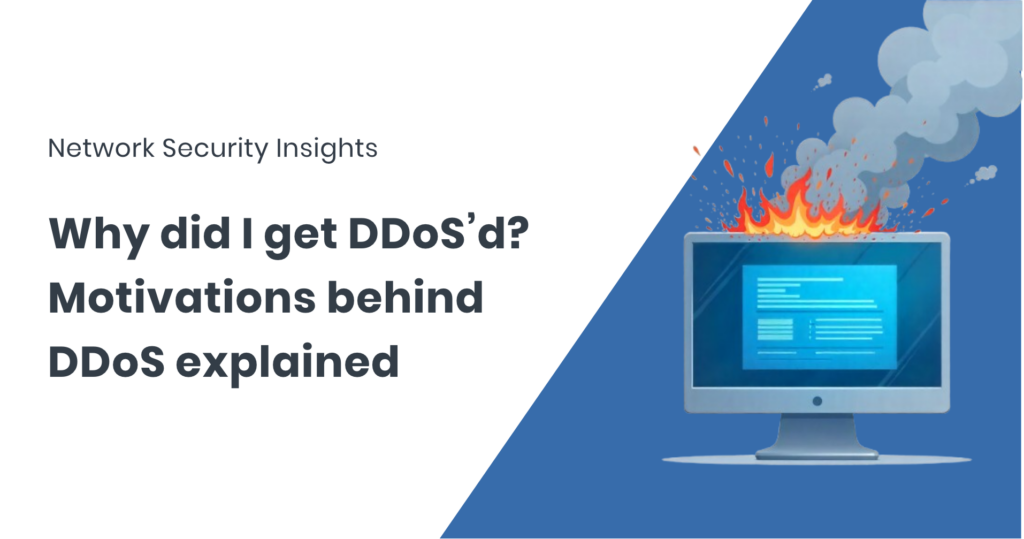We often talk about how DDoS attacks happen — via botnets, traffic floods, vectors — but rarely do we ask the more human question: why?
The truth is, behind every DDoS attack is a motive. Sometimes it’s financial. Sometimes it’s political. And sometimes it’s just personal.
Here’s a closer look at the most common reasons these attacks occur.
According to industry reports
Several industry reports indicate growth in both the number and volume of DDoS attacks, underscoring the expanding scale of the threat. In many cases, however, the attacker is unknown, not publicly reported, or the victim chooses not to disclose details for security reasons. Data on the specific motivations behind attacks is limited, but one recent industry report* was able to analyse self-reported causes from the victims:
- 63% said ‘competitor’ was the culprit (common in gaming, gambling, crypto sectors)
- 21% attributed the attack to state-level or state-sponsored actors
- 5% each blamed disgruntled customers
- 5% reported a self-caused bug (e.g. accidental self-inflicted DDoS)
- 5% said they were a victim of an RDDoS attack (extortionist demanding a ransom)
Major motivations behind DDoS explained
1. Competitive sabotage
In industries like gaming, crypto services, or online betting, rivals or insiders launch DDoS at the worst time possible — during product launches, tournaments, or promotional events. This tactic targets availability, reputation, and revenue, and is reported in over 60% of identifiable cases. FastNetMon has documented similar patterns in its coverage of infrastructure-targeted incidents that disrupted trust in emerging platforms.
2. Extortion (Ransom DDoS, “RDDoS”)
Attackers increasingly pair threats with demands: pay us or face larger, prolonged disruption later. Industry reports note a significant rise in ransom-style threats. These campaigns often follow successful test floods that reveal defensive gaps and are most effective against organisations under time pressure.
3. Geopolitical or ideological campaigns
State-linked groups or activists often deploy DDoS as a digital protest tool — to disrupt critical infrastructure, media outlets, or financial services in specific countries. Industry analysis found that 21% of identified cases were tied to political operations or state-sponsored cyber activity.
FastNetMon’s recent reporting on the Monero-aligned Qubics takeover attempt illustrates how such campaigns may mix ideology with spectacle, aiming to destabilise or provoke rather than generate direct profit.
4. Hacktivism or protest
Motivated by ideology or protest, hacktivist groups like NoName(057)16 launch DDoS campaigns against government agencies, universities, or corporations they oppose. These campaigns may be publicly claimed or shrouded in anonymity, making attribution difficult, but their goal is primarily disruption rather than technical outcome.
5. Personal vendettas or trolling
In gaming communities and small-scale environments, DDoS is still used as a revenge tool. A disgruntled player might knock a server offline to reset leaderboards or force resignation. These attacks are seldom publicised or traced, with industry reports classifying many as ‘disgruntled user’ cases (~5%).
6. Diversion tactics
Malicious actors sometimes launch noisy floods to distract defenders while executing more subtle operations like malware deployment or data theft. These diversion attacks may not reach high volumes and often go unreported, but when investigated, they reveal coordinated campaigns using fake DDoS alarms as cover for real compromise.
Understanding attacker motivation: the key to effective defence
Understanding why a DDoS attack occurs is as important as knowing how it happens. Motivation directly influences the attack’s timing, intensity, and persistence, which in turn determines how organisations should respond.
Competitor-driven attacks and ransom-style threats demand rapid detection and strong forensic readiness to minimise business impact. Politically motivated or hacktivist campaigns require a layered defence approach, combining technical mitigation with strategic communication and public response planning. Even low-profile attacks, such as personal vendettas, can cause disruption if left unchecked, making anomaly detection and reputation monitoring essential.
By analysing attacker motives, security teams can anticipate patterns, prioritise resources, and tailor defences to specific threats. DDoS has never been a homogeneous problem — it is a spectrum of challenges shaped by human intent. Adapting defences to these motivations is the most effective way to stay one step ahead.
About FastNetMon
FastNetMon is a leading solution for network security, offering advanced DDoS detection and mitigation. With real-time analytics and rapid response capabilities, FastNetMon helps organisations protect their infrastructure from evolving cyber threats. For more information, visit https://fastnetmon.com
- Data source: Cloudflare’s 2025 Q2 DDoS threat report

